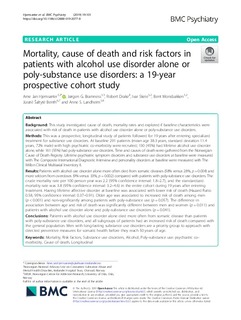| dc.description.abstract | Background This study investigated cause of death, mortality rates and explored if baseline characteristics were associated with risk of death in patients with alcohol use disorder alone or poly-substance use disorders. Methods This was a prospective, longitudinal study of patients followed for 19 years after entering specialized treatment for substance use disorders. At baseline 291 patients (mean age 38.3 years, standard deviation 11.4 years, 72% male) with high psychiatric co-morbidity were recruited; 130 (45%) had lifetime alcohol use disorder alone, while 161 (55%) had poly-substance use disorders. Time and causes of death were gathered from the Norwegian Cause of Death Registry. Lifetime psychiatric symptom disorders and substance use disorders at baseline were measured with The Composite International Diagnostic Interview and personality disorders at baseline were measured with The Millon Clinical Multiaxial Inventory II. Results Patients with alcohol use disorder alone more often died from somatic diseases (58% versus 28%, p = 0.004) and more seldom from overdoses (9% versus 33%, p = 0.002) compared with patients with poly-substance use disorders. The crude mortality rate per 100 person year was 2.2 (95% confidence interval: 1.8–2.7), and the standardized mortality rate was 3.8 (95% confidence interval: 3.2–4.6) in the entire cohort during 19 years after entering treatment. Having lifetime affective disorder at baseline was associated with lower risk of death (Hazard Ratio 0.58, 95% confidence interval: 0.37–0.91). Older age was associated to increased risk of death among men (p < 0.001) and non-significantly among patients with poly-substance use (p = 0.057). The difference in association between age and risk of death was significantly different between men and women (p = 0.011) and patients with alcohol use disorder alone and poly-substance use disorders (p = 0.041). Conclusions Patients with alcohol use disorder alone died more often from somatic disease than patients with poly-substance use disorders, and all subgroups of patients had an increased risk of death compared with the general population. Men with long-lasting substance use disorders are a priority group to approach with directed preventive measures for somatic health before they reach 50 years of age. | |
